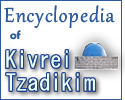Rabbi Yitzchak Luria
From Zissil
Warning: You are not logged in.
Your IP address will be recorded in this page's edit history.The edit can be undone.
Please check the comparison below to verify that this is what you want to do, and then save the changes below to finish undoing the edit.
| Latest revision | Your text | ||
| Line 21: | Line 21: | ||
==Youth== | ==Youth== | ||
Rabbi Yitzchak Luria was born in 1534 to his father Rabbi Shlomo in Yerushalaim. In his early youth he became orphaned from his father and moved with his mother to Egypt to the home of his wealthy uncle Mordechai Frances. There the Ari studied under the [[Rabbi David Ben Zimra - Radbaz|Radbaz]] and his student Rabbi Bezalel Ashkenazi. At age 15 the Arizal married the daughter of his uncle, spending the next six years studying with Rabbi Bezalel Ashkenazi. He helped his teacher create the Shita Mikubetzet on a few tracts of Talmud. After this the Arizal spent 8 years in solitary conclusion, meditating and studying [[Kabbalah]] in a small room on the banks of the Nile river. He would only come home on Shabbot and would only speak in Lashon Hakodesh even to his wife. | Rabbi Yitzchak Luria was born in 1534 to his father Rabbi Shlomo in Yerushalaim. In his early youth he became orphaned from his father and moved with his mother to Egypt to the home of his wealthy uncle Mordechai Frances. There the Ari studied under the [[Rabbi David Ben Zimra - Radbaz|Radbaz]] and his student Rabbi Bezalel Ashkenazi. At age 15 the Arizal married the daughter of his uncle, spending the next six years studying with Rabbi Bezalel Ashkenazi. He helped his teacher create the Shita Mikubetzet on a few tracts of Talmud. After this the Arizal spent 8 years in solitary conclusion, meditating and studying [[Kabbalah]] in a small room on the banks of the Nile river. He would only come home on Shabbot and would only speak in Lashon Hakodesh even to his wife. | ||
| − | |||
| − | |||
| − | |||
==Eretz Yisroel== | ==Eretz Yisroel== | ||
| − | In 1570 at age 36, the | + | In 1570 at age 36, the Arial returned to Eretz Yisroel and settled in Tzfat. |
===Yerushalaim=== | ===Yerushalaim=== | ||
| Line 36: | Line 33: | ||
==Students== | ==Students== | ||
Referred to as the Guri HaAri (the lion cubs), the students of the Arizal included Rabbi Chaim Vital, [[Rabbi Yehoshua Ben Nun]]. | Referred to as the Guri HaAri (the lion cubs), the students of the Arizal included Rabbi Chaim Vital, [[Rabbi Yehoshua Ben Nun]]. | ||
| − | |||
| − | |||
| − | |||
| − | |||
| − | |||
| − | |||
| − | |||
| − | |||
| − | |||
| − | |||
| − | |||
| − | |||
| − | |||
| − | |||
==Synagogues and Mikva== | ==Synagogues and Mikva== | ||
| Line 81: | Line 64: | ||
File:00000708-corner-of-kever-haari.jpg | File:00000708-corner-of-kever-haari.jpg | ||
File:00000698-chasidim-walking-to-kever-ari.jpg | File:00000698-chasidim-walking-to-kever-ari.jpg | ||
| − | + | ||
| − | + | ||
| − | + | ||
</gallery> | </gallery> | ||

